Database Project: Shoengalleric Art Gallery Design & Development
VerifiedAdded on 2024/05/20
|74
|6401
|66
Project
AI Summary
This project presents the design and development of a database for Shoengalleric Art Gallery using MS Access. The project addresses the challenges of managing data for the gallery's branches, staff, artists, artworks, and events. It outlines the system and user requirements, and the conceptual and logical database designs, including entity-relationship diagrams. The database comprises interrelated tables with primary and foreign keys to maintain data integrity. The report details the creation of tables for artwork style, artist specifications, artwork collection, events, booking specifications, customer details, staff members, and gallery specifications. Furthermore, the project includes the development of user interfaces in the form of forms for data input and management, along with SQL queries for data retrieval and reporting. The functionality and working of the database are analyzed through several test cases, with technical and user documentation provided to guide implementation and usage.

Database Design and Development
1
1
Paraphrase This Document
Need a fresh take? Get an instant paraphrase of this document with our AI Paraphraser

Contents
Introduction....................................................................................................................................10
LO1 Use an appropriate design tool to design a relational database system for a substantial
problem..........................................................................................................................................11
P1 Design a relational database system using appropriate design tools and techniques,
containing at least four interrelated tables, with clear statements of user and system
requirements..............................................................................................................................11
LO2 Develop a fully functional relational database system, based on an existing system design22
P2 Develop the database system with evidence of user interface, output, and data validations,
and querying across multiple tables...........................................................................................22
LO3 Test the systems against user and system requirements........................................................35
P3 Implement a query language into the relational database system........................................35
LO4 Produce technical and user documentation...........................................................................45
P4 Test the system against user and system requirements........................................................45
P5: Produce technical and user documentation.........................................................................59
Conclusion.....................................................................................................................................73
2
Introduction....................................................................................................................................10
LO1 Use an appropriate design tool to design a relational database system for a substantial
problem..........................................................................................................................................11
P1 Design a relational database system using appropriate design tools and techniques,
containing at least four interrelated tables, with clear statements of user and system
requirements..............................................................................................................................11
LO2 Develop a fully functional relational database system, based on an existing system design22
P2 Develop the database system with evidence of user interface, output, and data validations,
and querying across multiple tables...........................................................................................22
LO3 Test the systems against user and system requirements........................................................35
P3 Implement a query language into the relational database system........................................35
LO4 Produce technical and user documentation...........................................................................45
P4 Test the system against user and system requirements........................................................45
P5: Produce technical and user documentation.........................................................................59
Conclusion.....................................................................................................................................73
2
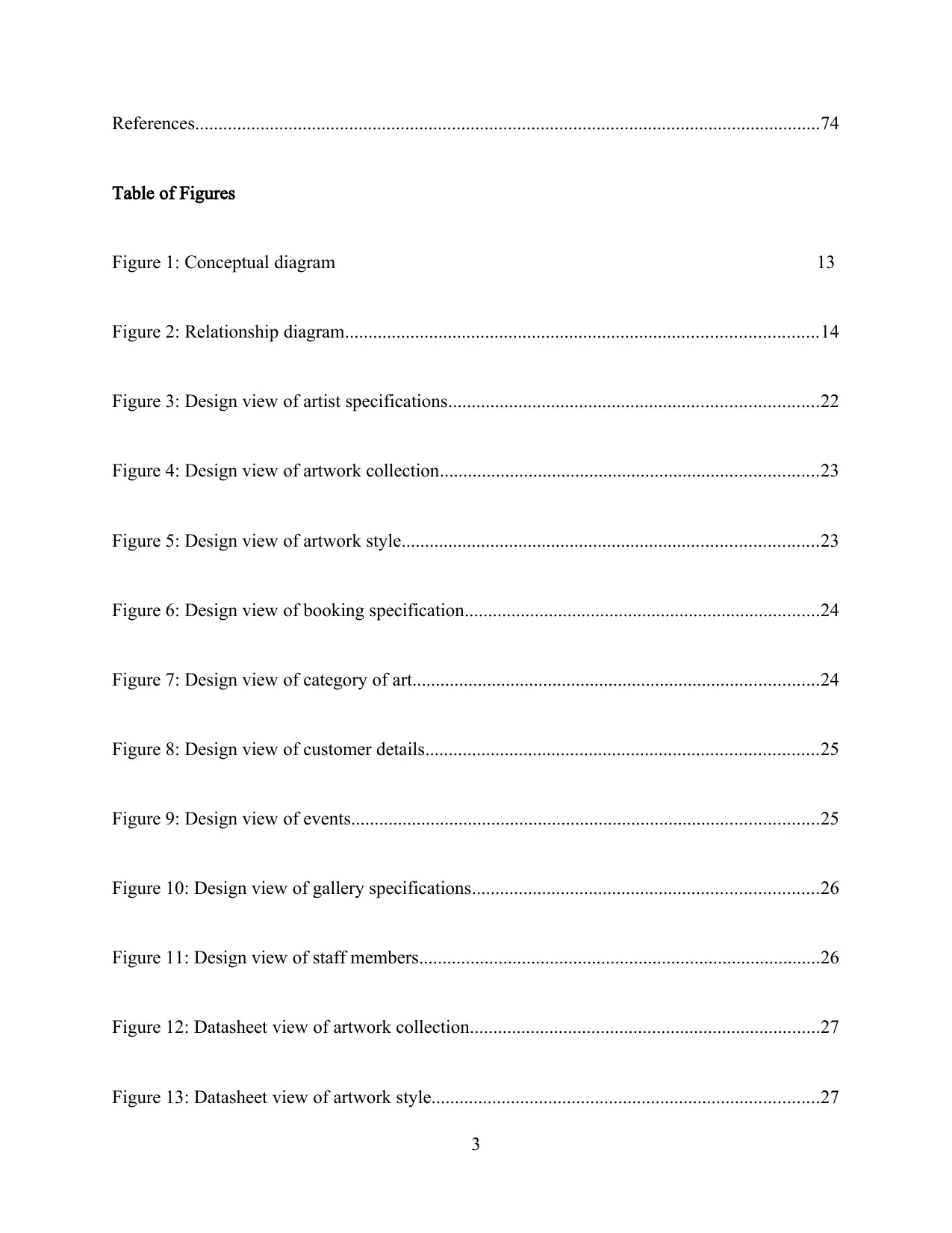
References......................................................................................................................................74
Table of Figures
Figure 1: Conceptual diagram 13
Figure 2: Relationship diagram.....................................................................................................14
Figure 3: Design view of artist specifications...............................................................................22
Figure 4: Design view of artwork collection.................................................................................23
Figure 5: Design view of artwork style.........................................................................................23
Figure 6: Design view of booking specification............................................................................24
Figure 7: Design view of category of art.......................................................................................24
Figure 8: Design view of customer details....................................................................................25
Figure 9: Design view of events....................................................................................................25
Figure 10: Design view of gallery specifications..........................................................................26
Figure 11: Design view of staff members......................................................................................26
Figure 12: Datasheet view of artwork collection...........................................................................27
Figure 13: Datasheet view of artwork style...................................................................................27
3
Table of Figures
Figure 1: Conceptual diagram 13
Figure 2: Relationship diagram.....................................................................................................14
Figure 3: Design view of artist specifications...............................................................................22
Figure 4: Design view of artwork collection.................................................................................23
Figure 5: Design view of artwork style.........................................................................................23
Figure 6: Design view of booking specification............................................................................24
Figure 7: Design view of category of art.......................................................................................24
Figure 8: Design view of customer details....................................................................................25
Figure 9: Design view of events....................................................................................................25
Figure 10: Design view of gallery specifications..........................................................................26
Figure 11: Design view of staff members......................................................................................26
Figure 12: Datasheet view of artwork collection...........................................................................27
Figure 13: Datasheet view of artwork style...................................................................................27
3
⊘ This is a preview!⊘
Do you want full access?
Subscribe today to unlock all pages.

Trusted by 1+ million students worldwide
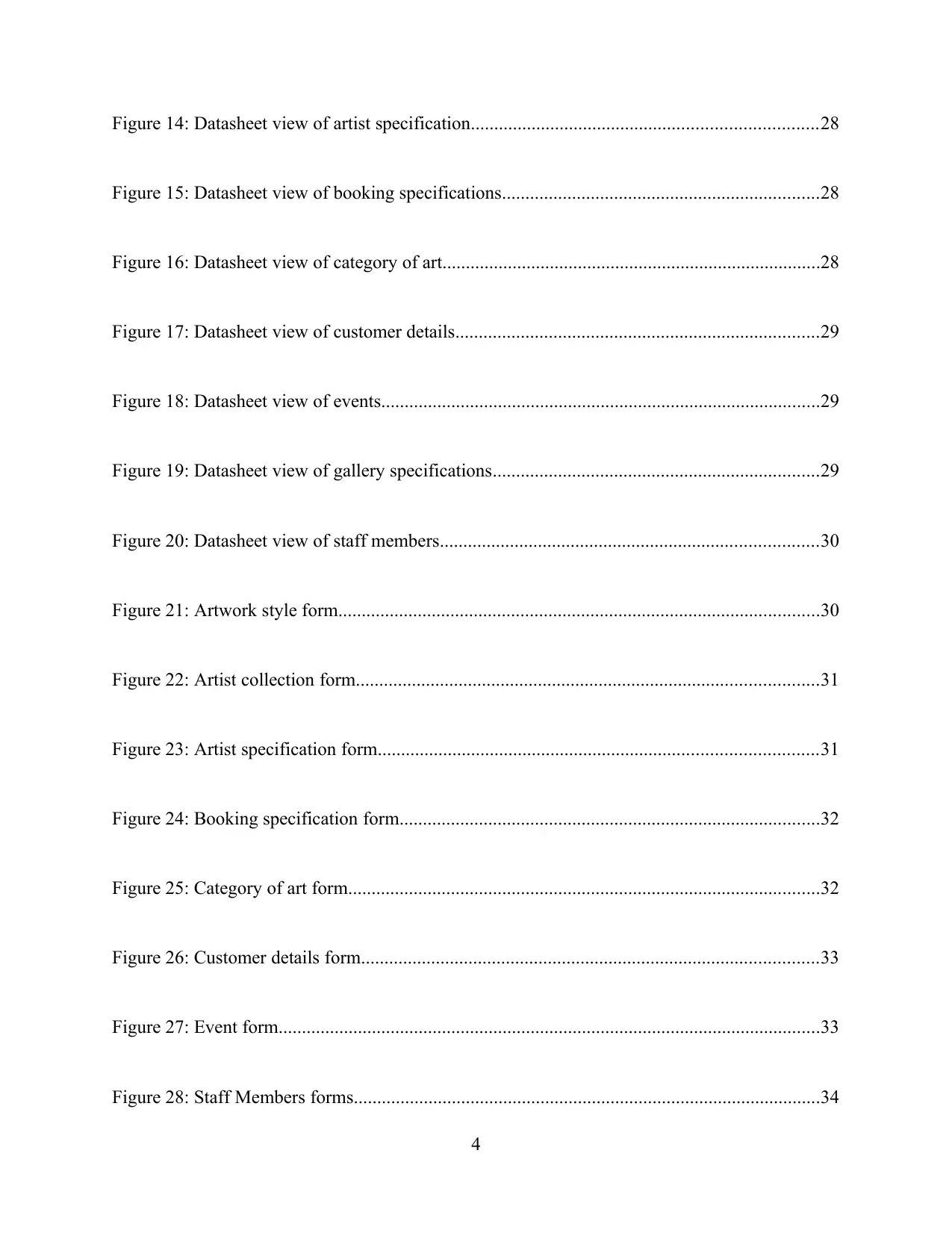
Figure 14: Datasheet view of artist specification..........................................................................28
Figure 15: Datasheet view of booking specifications....................................................................28
Figure 16: Datasheet view of category of art.................................................................................28
Figure 17: Datasheet view of customer details..............................................................................29
Figure 18: Datasheet view of events..............................................................................................29
Figure 19: Datasheet view of gallery specifications......................................................................29
Figure 20: Datasheet view of staff members.................................................................................30
Figure 21: Artwork style form.......................................................................................................30
Figure 22: Artist collection form...................................................................................................31
Figure 23: Artist specification form..............................................................................................31
Figure 24: Booking specification form..........................................................................................32
Figure 25: Category of art form.....................................................................................................32
Figure 26: Customer details form..................................................................................................33
Figure 27: Event form....................................................................................................................33
Figure 28: Staff Members forms....................................................................................................34
4
Figure 15: Datasheet view of booking specifications....................................................................28
Figure 16: Datasheet view of category of art.................................................................................28
Figure 17: Datasheet view of customer details..............................................................................29
Figure 18: Datasheet view of events..............................................................................................29
Figure 19: Datasheet view of gallery specifications......................................................................29
Figure 20: Datasheet view of staff members.................................................................................30
Figure 21: Artwork style form.......................................................................................................30
Figure 22: Artist collection form...................................................................................................31
Figure 23: Artist specification form..............................................................................................31
Figure 24: Booking specification form..........................................................................................32
Figure 25: Category of art form.....................................................................................................32
Figure 26: Customer details form..................................................................................................33
Figure 27: Event form....................................................................................................................33
Figure 28: Staff Members forms....................................................................................................34
4
Paraphrase This Document
Need a fresh take? Get an instant paraphrase of this document with our AI Paraphraser

Figure 29: Query 1 datasheet view................................................................................................35
Figure 30: Query 1 design view.....................................................................................................36
Figure 31: Query 1 SQL view.......................................................................................................36
Figure 32: Query 2 datasheet view................................................................................................37
Figure 33: Query 2 design view.....................................................................................................37
Figure 34: Query 2 SQL view.......................................................................................................37
Figure 35: Query 3 datasheet view................................................................................................38
Figure 36: Query 3 design view.....................................................................................................38
Figure 37: Query 3 SQL view.......................................................................................................38
Figure 38: Query 4 datasheet view................................................................................................39
Figure 39: Query 4 design view.....................................................................................................40
Figure 40: Query 4 SQL view.......................................................................................................40
Figure 41: Query 5 datasheet view................................................................................................41
Figure 42: Query 5 design view.....................................................................................................41
Figure 43: Query 5 SQL view.......................................................................................................42
5
Figure 30: Query 1 design view.....................................................................................................36
Figure 31: Query 1 SQL view.......................................................................................................36
Figure 32: Query 2 datasheet view................................................................................................37
Figure 33: Query 2 design view.....................................................................................................37
Figure 34: Query 2 SQL view.......................................................................................................37
Figure 35: Query 3 datasheet view................................................................................................38
Figure 36: Query 3 design view.....................................................................................................38
Figure 37: Query 3 SQL view.......................................................................................................38
Figure 38: Query 4 datasheet view................................................................................................39
Figure 39: Query 4 design view.....................................................................................................40
Figure 40: Query 4 SQL view.......................................................................................................40
Figure 41: Query 5 datasheet view................................................................................................41
Figure 42: Query 5 design view.....................................................................................................41
Figure 43: Query 5 SQL view.......................................................................................................42
5
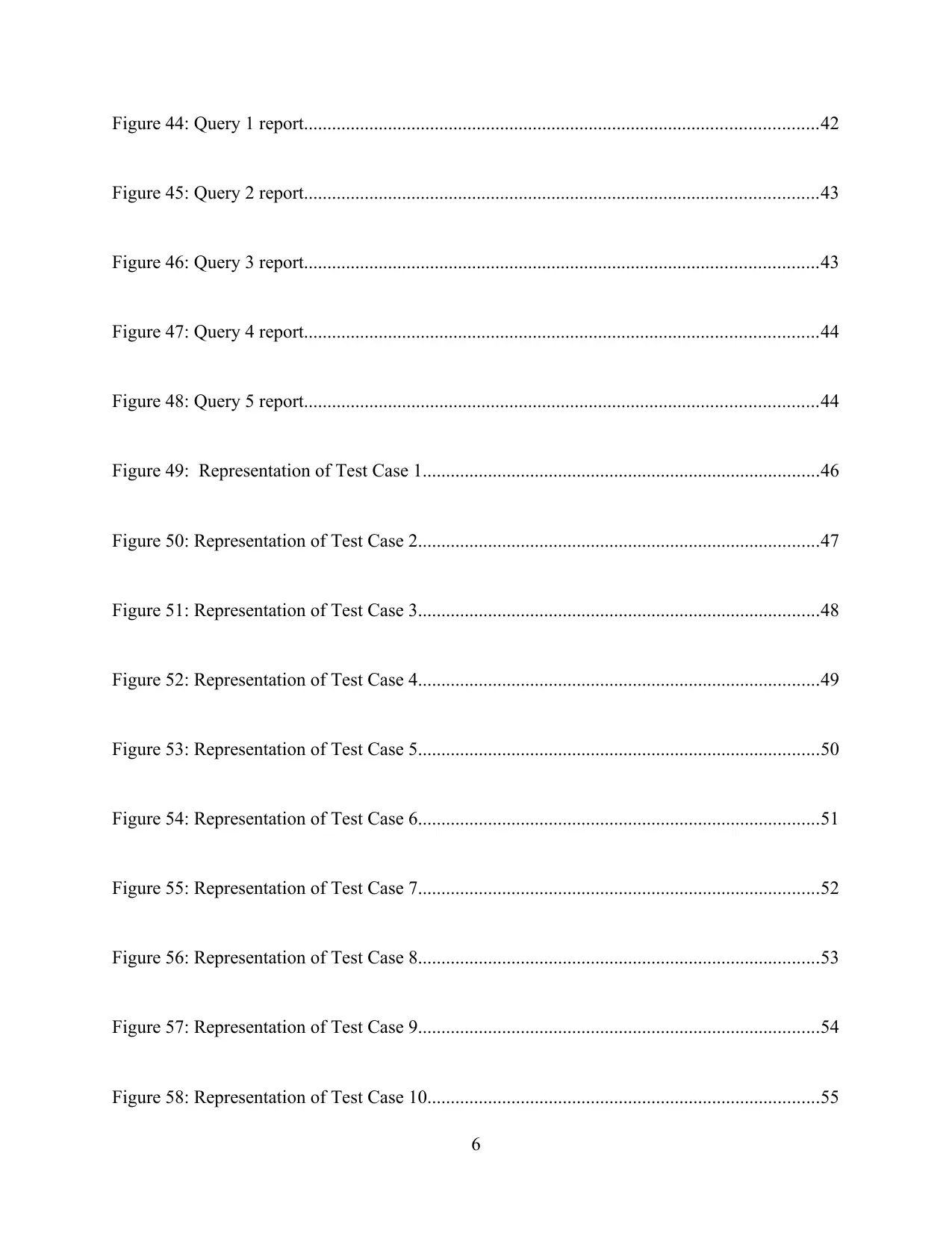
Figure 44: Query 1 report..............................................................................................................42
Figure 45: Query 2 report..............................................................................................................43
Figure 46: Query 3 report..............................................................................................................43
Figure 47: Query 4 report..............................................................................................................44
Figure 48: Query 5 report..............................................................................................................44
Figure 49: Representation of Test Case 1.....................................................................................46
Figure 50: Representation of Test Case 2......................................................................................47
Figure 51: Representation of Test Case 3......................................................................................48
Figure 52: Representation of Test Case 4......................................................................................49
Figure 53: Representation of Test Case 5......................................................................................50
Figure 54: Representation of Test Case 6......................................................................................51
Figure 55: Representation of Test Case 7......................................................................................52
Figure 56: Representation of Test Case 8......................................................................................53
Figure 57: Representation of Test Case 9......................................................................................54
Figure 58: Representation of Test Case 10....................................................................................55
6
Figure 45: Query 2 report..............................................................................................................43
Figure 46: Query 3 report..............................................................................................................43
Figure 47: Query 4 report..............................................................................................................44
Figure 48: Query 5 report..............................................................................................................44
Figure 49: Representation of Test Case 1.....................................................................................46
Figure 50: Representation of Test Case 2......................................................................................47
Figure 51: Representation of Test Case 3......................................................................................48
Figure 52: Representation of Test Case 4......................................................................................49
Figure 53: Representation of Test Case 5......................................................................................50
Figure 54: Representation of Test Case 6......................................................................................51
Figure 55: Representation of Test Case 7......................................................................................52
Figure 56: Representation of Test Case 8......................................................................................53
Figure 57: Representation of Test Case 9......................................................................................54
Figure 58: Representation of Test Case 10....................................................................................55
6
⊘ This is a preview!⊘
Do you want full access?
Subscribe today to unlock all pages.

Trusted by 1+ million students worldwide
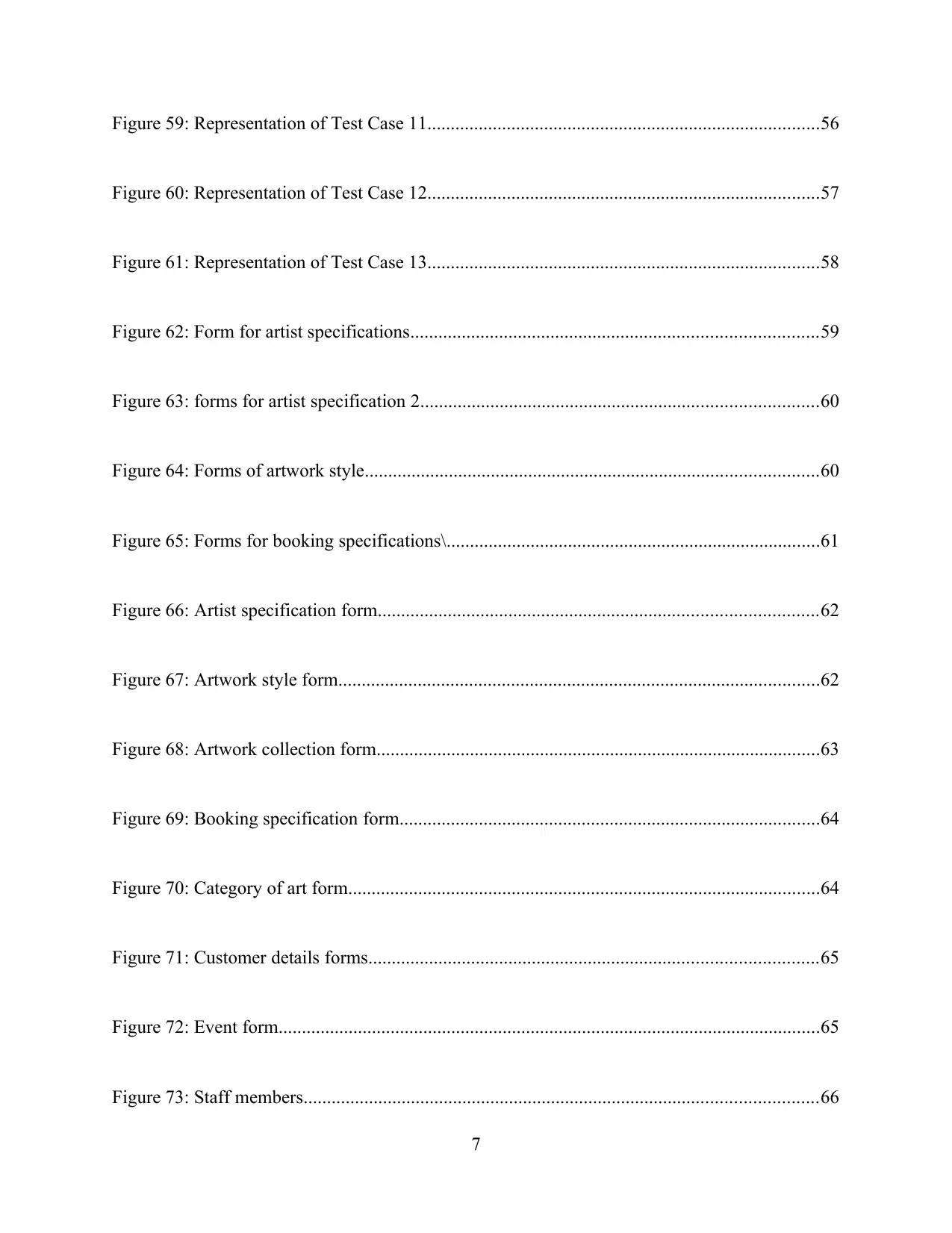
Figure 59: Representation of Test Case 11....................................................................................56
Figure 60: Representation of Test Case 12....................................................................................57
Figure 61: Representation of Test Case 13....................................................................................58
Figure 62: Form for artist specifications.......................................................................................59
Figure 63: forms for artist specification 2.....................................................................................60
Figure 64: Forms of artwork style.................................................................................................60
Figure 65: Forms for booking specifications\................................................................................61
Figure 66: Artist specification form..............................................................................................62
Figure 67: Artwork style form.......................................................................................................62
Figure 68: Artwork collection form...............................................................................................63
Figure 69: Booking specification form..........................................................................................64
Figure 70: Category of art form.....................................................................................................64
Figure 71: Customer details forms................................................................................................65
Figure 72: Event form....................................................................................................................65
Figure 73: Staff members..............................................................................................................66
7
Figure 60: Representation of Test Case 12....................................................................................57
Figure 61: Representation of Test Case 13....................................................................................58
Figure 62: Form for artist specifications.......................................................................................59
Figure 63: forms for artist specification 2.....................................................................................60
Figure 64: Forms of artwork style.................................................................................................60
Figure 65: Forms for booking specifications\................................................................................61
Figure 66: Artist specification form..............................................................................................62
Figure 67: Artwork style form.......................................................................................................62
Figure 68: Artwork collection form...............................................................................................63
Figure 69: Booking specification form..........................................................................................64
Figure 70: Category of art form.....................................................................................................64
Figure 71: Customer details forms................................................................................................65
Figure 72: Event form....................................................................................................................65
Figure 73: Staff members..............................................................................................................66
7
Paraphrase This Document
Need a fresh take? Get an instant paraphrase of this document with our AI Paraphraser

Figure 74: Design view of artist specifications.............................................................................67
Figure 75: Design view of artwork collection...............................................................................67
Figure 76: Design view of artwork style.......................................................................................68
Figure 77: Design view of booking specification..........................................................................68
Figure 78: Design view of category of art.....................................................................................69
Figure 79: Design view of customer details..................................................................................69
Figure 80: Design view of events..................................................................................................70
Figure 81: Design view of gallery specifications..........................................................................70
Figure 82: Design view of staff members......................................................................................71
Figure 83: Datasheet view of query...............................................................................................71
Figure 84: SQL view of query.......................................................................................................72
Figure 85: Datasheet view of query...............................................................................................72
Figure 86: SQL view of query.......................................................................................................72
8
Figure 75: Design view of artwork collection...............................................................................67
Figure 76: Design view of artwork style.......................................................................................68
Figure 77: Design view of booking specification..........................................................................68
Figure 78: Design view of category of art.....................................................................................69
Figure 79: Design view of customer details..................................................................................69
Figure 80: Design view of events..................................................................................................70
Figure 81: Design view of gallery specifications..........................................................................70
Figure 82: Design view of staff members......................................................................................71
Figure 83: Datasheet view of query...............................................................................................71
Figure 84: SQL view of query.......................................................................................................72
Figure 85: Datasheet view of query...............................................................................................72
Figure 86: SQL view of query.......................................................................................................72
8
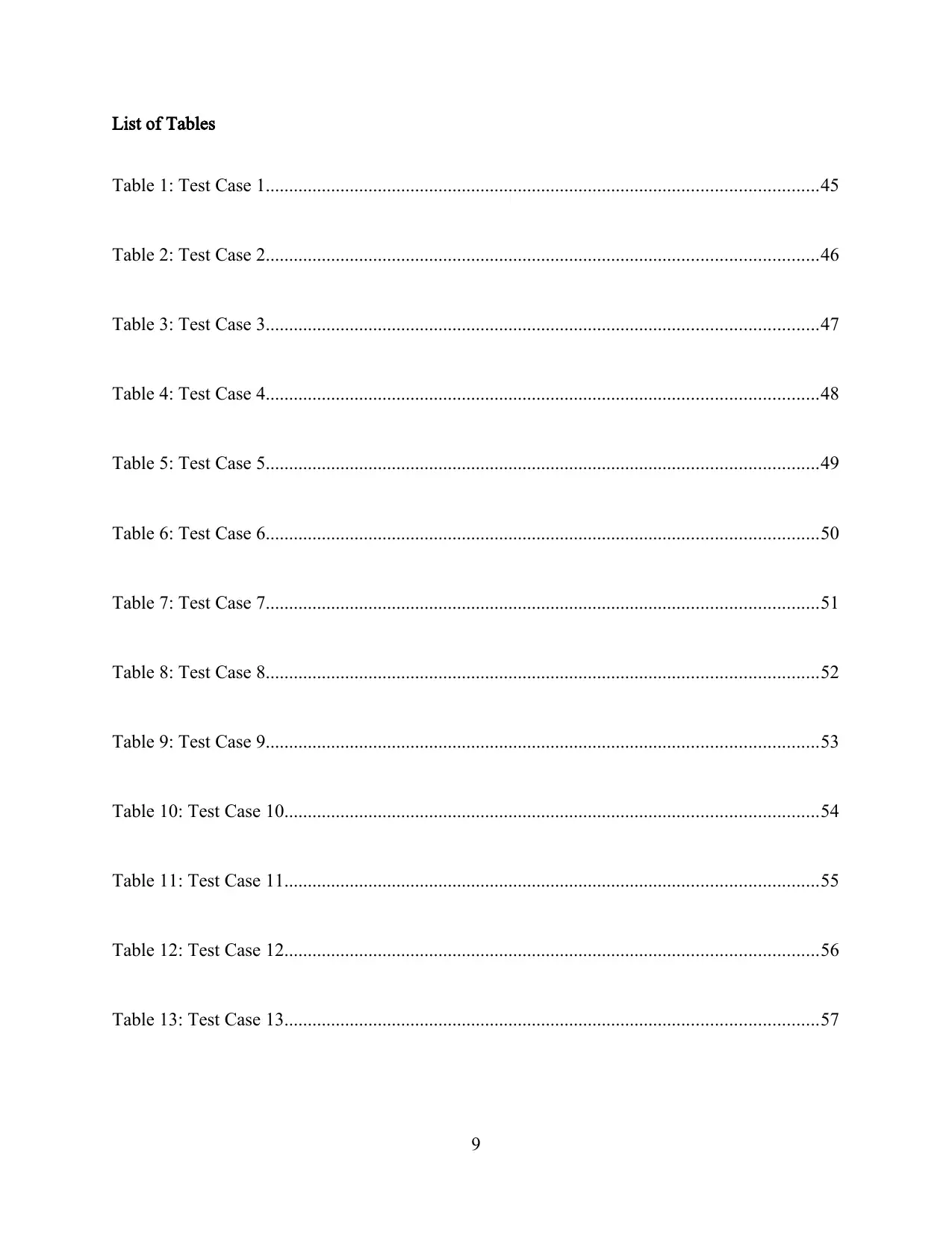
List of Tables
Table 1: Test Case 1......................................................................................................................45
Table 2: Test Case 2......................................................................................................................46
Table 3: Test Case 3......................................................................................................................47
Table 4: Test Case 4......................................................................................................................48
Table 5: Test Case 5......................................................................................................................49
Table 6: Test Case 6......................................................................................................................50
Table 7: Test Case 7......................................................................................................................51
Table 8: Test Case 8......................................................................................................................52
Table 9: Test Case 9......................................................................................................................53
Table 10: Test Case 10..................................................................................................................54
Table 11: Test Case 11..................................................................................................................55
Table 12: Test Case 12..................................................................................................................56
Table 13: Test Case 13..................................................................................................................57
9
Table 1: Test Case 1......................................................................................................................45
Table 2: Test Case 2......................................................................................................................46
Table 3: Test Case 3......................................................................................................................47
Table 4: Test Case 4......................................................................................................................48
Table 5: Test Case 5......................................................................................................................49
Table 6: Test Case 6......................................................................................................................50
Table 7: Test Case 7......................................................................................................................51
Table 8: Test Case 8......................................................................................................................52
Table 9: Test Case 9......................................................................................................................53
Table 10: Test Case 10..................................................................................................................54
Table 11: Test Case 11..................................................................................................................55
Table 12: Test Case 12..................................................................................................................56
Table 13: Test Case 13..................................................................................................................57
9
⊘ This is a preview!⊘
Do you want full access?
Subscribe today to unlock all pages.

Trusted by 1+ million students worldwide

Introduction
The report provided below contains the database development and design for Shoengalleric Art
Gallery. It’s an art gallery located in China and has its branches at several places. Director of the
gallery manages the whole process taking place in the gallery and different branches have their
branch manager who looks after everyday gallery issues. The gallery has a complete staff
including administrator, booking assistant, technician, preparatory and gallery assistants.
Using the application of MS Access a complete database is designed and created for
Shoengalleric Art Gallery. The developed database includes interrelated tables having both
primary as well as foreign keys. The database developed maintains the integrity of stored data.
The generated database comprises of various tables showing different entities, its forms, queries,
and developed relationships. The report also consists of several test cases executed to analyze
functionality and working of the database.
10
The report provided below contains the database development and design for Shoengalleric Art
Gallery. It’s an art gallery located in China and has its branches at several places. Director of the
gallery manages the whole process taking place in the gallery and different branches have their
branch manager who looks after everyday gallery issues. The gallery has a complete staff
including administrator, booking assistant, technician, preparatory and gallery assistants.
Using the application of MS Access a complete database is designed and created for
Shoengalleric Art Gallery. The developed database includes interrelated tables having both
primary as well as foreign keys. The database developed maintains the integrity of stored data.
The generated database comprises of various tables showing different entities, its forms, queries,
and developed relationships. The report also consists of several test cases executed to analyze
functionality and working of the database.
10
Paraphrase This Document
Need a fresh take? Get an instant paraphrase of this document with our AI Paraphraser
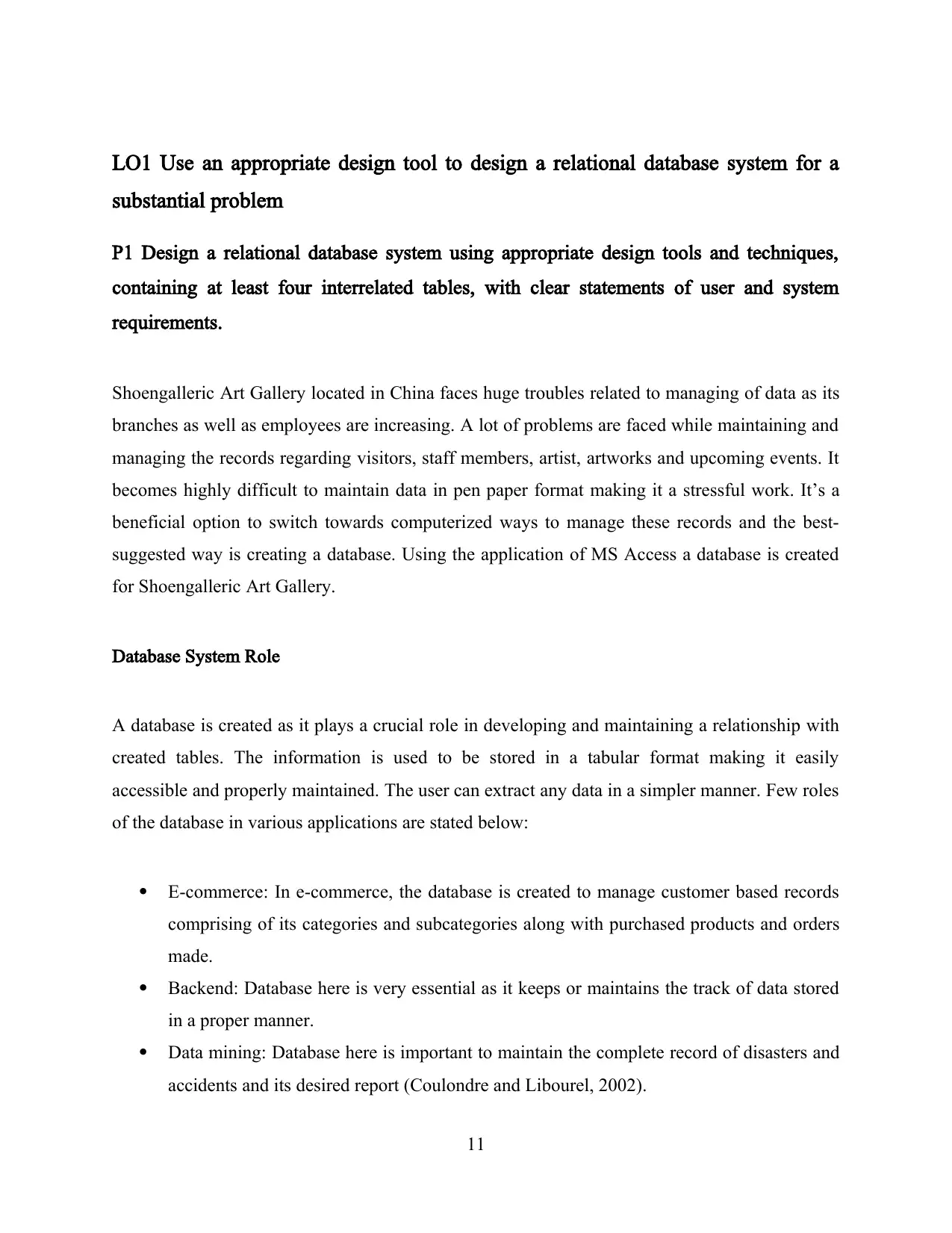
LO1 Use an appropriate design tool to design a relational database system for a
substantial problem
P1 Design a relational database system using appropriate design tools and techniques,
containing at least four interrelated tables, with clear statements of user and system
requirements.
Shoengalleric Art Gallery located in China faces huge troubles related to managing of data as its
branches as well as employees are increasing. A lot of problems are faced while maintaining and
managing the records regarding visitors, staff members, artist, artworks and upcoming events. It
becomes highly difficult to maintain data in pen paper format making it a stressful work. It’s a
beneficial option to switch towards computerized ways to manage these records and the best-
suggested way is creating a database. Using the application of MS Access a database is created
for Shoengalleric Art Gallery.
Database System Role
A database is created as it plays a crucial role in developing and maintaining a relationship with
created tables. The information is used to be stored in a tabular format making it easily
accessible and properly maintained. The user can extract any data in a simpler manner. Few roles
of the database in various applications are stated below:
E-commerce: In e-commerce, the database is created to manage customer based records
comprising of its categories and subcategories along with purchased products and orders
made.
Backend: Database here is very essential as it keeps or maintains the track of data stored
in a proper manner.
Data mining: Database here is important to maintain the complete record of disasters and
accidents and its desired report (Coulondre and Libourel, 2002).
11
substantial problem
P1 Design a relational database system using appropriate design tools and techniques,
containing at least four interrelated tables, with clear statements of user and system
requirements.
Shoengalleric Art Gallery located in China faces huge troubles related to managing of data as its
branches as well as employees are increasing. A lot of problems are faced while maintaining and
managing the records regarding visitors, staff members, artist, artworks and upcoming events. It
becomes highly difficult to maintain data in pen paper format making it a stressful work. It’s a
beneficial option to switch towards computerized ways to manage these records and the best-
suggested way is creating a database. Using the application of MS Access a database is created
for Shoengalleric Art Gallery.
Database System Role
A database is created as it plays a crucial role in developing and maintaining a relationship with
created tables. The information is used to be stored in a tabular format making it easily
accessible and properly maintained. The user can extract any data in a simpler manner. Few roles
of the database in various applications are stated below:
E-commerce: In e-commerce, the database is created to manage customer based records
comprising of its categories and subcategories along with purchased products and orders
made.
Backend: Database here is very essential as it keeps or maintains the track of data stored
in a proper manner.
Data mining: Database here is important to maintain the complete record of disasters and
accidents and its desired report (Coulondre and Libourel, 2002).
11

User requirement and system requirement
Requirements of System: Any database developed requires both hardware and software as its
system requirement.
Hardware requirements: Some basic hardware’s that meets up the requirements or needs of the
database developed are called hardware requirements. It comprises of:
A display having a resolution of 1024*468.
The processor of at least 64-bit.
A minimum of 2 GB RAM.
Software requirements: Some basic software’s that meets up the requirements or needs of the
database developed are called software requirements. MS Access is the software used for the
development of database and conceptual as well as logical diagrams are designed using e-draw
or draw.io software’s (Hasling, Goetz and Beetz, 2008).
Conceptual design for database
The Conceptual design for database explains the relationship among several defined entities and
its following attributes. They are also called Entity-Relationship diagram. It mainly comprises
of:
Entities: They are several defined objects of real world created in form of tables which
completely depends on the user and functional requirements.
Attributes: They are defined as entities sub-properties.
Relationships: A relationship is defined among various introduced entities by connecting
them with one another. The property of cardinality is defined among the set of entities
that can be one to one, one to many, many to many and many to one (Wang, Shen, Xie,
Neelamkavil and Pardasani, 2002).
12
Requirements of System: Any database developed requires both hardware and software as its
system requirement.
Hardware requirements: Some basic hardware’s that meets up the requirements or needs of the
database developed are called hardware requirements. It comprises of:
A display having a resolution of 1024*468.
The processor of at least 64-bit.
A minimum of 2 GB RAM.
Software requirements: Some basic software’s that meets up the requirements or needs of the
database developed are called software requirements. MS Access is the software used for the
development of database and conceptual as well as logical diagrams are designed using e-draw
or draw.io software’s (Hasling, Goetz and Beetz, 2008).
Conceptual design for database
The Conceptual design for database explains the relationship among several defined entities and
its following attributes. They are also called Entity-Relationship diagram. It mainly comprises
of:
Entities: They are several defined objects of real world created in form of tables which
completely depends on the user and functional requirements.
Attributes: They are defined as entities sub-properties.
Relationships: A relationship is defined among various introduced entities by connecting
them with one another. The property of cardinality is defined among the set of entities
that can be one to one, one to many, many to many and many to one (Wang, Shen, Xie,
Neelamkavil and Pardasani, 2002).
12
⊘ This is a preview!⊘
Do you want full access?
Subscribe today to unlock all pages.

Trusted by 1+ million students worldwide
1 out of 74
Related Documents
Your All-in-One AI-Powered Toolkit for Academic Success.
+13062052269
info@desklib.com
Available 24*7 on WhatsApp / Email
![[object Object]](/_next/static/media/star-bottom.7253800d.svg)
Unlock your academic potential
Copyright © 2020–2025 A2Z Services. All Rights Reserved. Developed and managed by ZUCOL.





